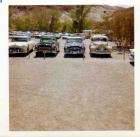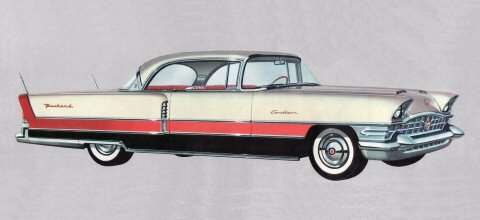|
Re: 2262-9 288 motor distribution tube
|
||||
|---|---|---|---|---|
|
Forum Ambassador
|
aljcampo-when you say "cleaned the block inside very well" what exactly does that mean? auto parts store hot tank?
IMHO if an engine is worth a rebuild the best money spent is to have the block, head and every other part that does not move chemically stripped with the "Chem-Strip" process, an Alkaline solution through which electrical current is passed. This cleans the block and head cooling passenges to a state of surgical cleanleness. This process can reach into every nook and cranny of the block's cooling passenges and puts the block back to where it was when it was new. I have taken old, tired engines that basically ran OK, a little smoky, a little noisy, but they would huff along BUT overheat at the drop of a hat, even after insuring that the radiator was in optimal condition. Did the rebuild, starting with the stripping process (the first step after dissassembling) and the problems just went away. The engine starts, after a short while the thermostat opens, goes to the rated temp and stays there. I really don't think you can undo 60 years of corrosion by mechanically abrading what can be reached through the freeze plug holes, or by using naval jelly. I understand that some shops now have the ability to glass bead the cooling passenges in a closed-loop sort of set up, and that would stand a good chance of getting most everywhere and cleaning to the absolute bare metal. I like to coat the inside of the cooling passenges with epoxy primer to retard future corrosion, a technique I learned from a coule of noted restorers, one of whom specializes in engines--he does 3-4 Deusenberg engines a year, Packard 8s and 12s and just about everything else. The thin film of primer does not seem to effect the heat transfer.
Posted on: 2010/9/16 8:20
|
|||
|
||||
|
Re: 2262-9 288 motor distribution tube
|
||||
|---|---|---|---|---|
|
Forum Ambassador

|
OTG -
Perhaps I can shed a little light. The cooling system under discussion is pressurized, and the radiator cap uses a pressure relief valve to build up pressure in the system, to a certain point. The pressure raises the boiling point of the engine coolant. I had to look it up, but it's 3 degrees (Fahrenheit) for each additional pound of pressure. The 15 degree difference between the normal boiling point of water, 212F, and the STB specification, 227F, suggests that a 5-lb. cap was used. However, the 48-54 parts book offers only a 7-lb. cap to service 48-50 models. With a 7-lb. cap, the boiling point of water in a '50 would be raised by 21 degrees, from 212F to 233F. Yet, there is another aspect to consider. An added benefit of using antifreeze is that it not only lowers the freezing point of the coolant mixture, but also raises the boiling point. A 50/50 mix of water and ethylene glycol boils at 223F. In that case, with a 7-lb. cap, you would then have an effective boiling point of 244F. However, you can't simply go to a higher pressure radiator cap to compensate for a overly hot condition. The rest of the cooling system must be designed and built to withstand the additional pressure.
Posted on: 2010/9/16 8:44
|
|||
|
||||
|
Re: 2262-9 288 motor distribution tube
|
||||
|---|---|---|---|---|
|
Forum Ambassador

|
Millions of cars have boiled over at one point or another as an occasional thing without suffering cracked blocks. But severely minimize how far you drive under that condition and don't do it as a matter of routine. But what surely will crack the block, generally at the exhaust valve seats, is adding cold water to an overheated engine which is low on coolant. If water is needed, allow the engine to cool down, and then add it SLOWLY with the engine running.
Just out of curiousity, what's the dimension between the fan blades and the radiator core? Are you certain the fan belt is riding on the tapered sides of the pulley and not at the bottom? A not uncommon reason for older cars overheating is installing a correct length but incorrect width fan belt - it's the tension of belt against the tapered side faces of the pulleys that provides the power to the water pump and fan.
Posted on: 2010/9/16 9:03
|
|||
|
||||
|
Re: 2262-9 288 motor distribution tube
|
||||
|---|---|---|---|---|
|
Home away from home

|
What BH said in post #13 is very well said. That is why I always ask why a person feels their engine is overheating. In my opinion the best indication of a cooling system that is not keeping up with the demand is when the system boils over. Assuming that the correct radiator cap is installed if the system is not boiling over then all is well. As stated in the above post #13 the 3 degree rise in the boiling point of the coolant for each pound pressure is correct BH stated that better than I did.
My opinion is that unless the gauge is pegged and steam is billowing out from under the hood it's ok. I have a 74 chevy van that I installed a mechanical temperature gauge on because I was concerned with temperature. On a normal to hot day the temperature runs between 220 and 240 degrees. Sometimes as high as 245. When I first saw that years ago I was concerned with the higher number but have since learned that is normal for that van. Boiling point of water, 212 + 45 pounds ( 15 lbs. X 3 degrees per pound rise 45 degree rise) = 257 degrees. Indicates that the 240 operating temperature indicated is well below the point where the system will boil over. If the designers felt it was necessary for the engine to run cooler they would have lowered the pressure set by the cap and made the radiator larger. Again Only my opinions. (Added later) Do heed the warning about adding cold water to a hot engine.Quote: Millions of cars have boiled over at one point or another as an occasional thing without suffering cracked blocks. But severely minimize how far you drive under that condition and don't do it as a matter of routine. But what surely will crack the block, generally at the exhaust valve seats, is adding cold water to an overheated engine which is low on coolant. If water is needed, allow the engine to cool down, and then add it SLOWLY with the engine running Owen said this well.
Posted on: 2010/9/16 13:22
|
|||
|
||||
|
Re: 2262-9 288 motor distribution tube
|
||||
|---|---|---|---|---|
|
Not too shy to talk

|
With regard to the overheating problem at the beginning of this thread.
My motor was also rebuilt ('52 327)...the distribution tube was clean..the water pump and radiator new and all specs were adhered to and still it overheated (boiled over). I retourqued the head to as tight as I could with a 1/2" ratchet and the problem was solved. An old timer told me they used to do it with an impact! (following the proper sequence of course) It worked for me...good luck!
Posted on: 2010/9/20 16:40
|
|||
|
||||
|
Re: 2262-9 288 motor distribution tube
|
||||
|---|---|---|---|---|
|
Forum Ambassador

|
Best to invest in a torque wrench, you'll get a lifetime of use from it. As to using an impact wrench, unless it can be accurately set to specification (62-65 pound-feet), you risk stretching the studs, possibly damaging the threads in the block and distorting the engine block itself. Very poor idea.
Posted on: 2010/9/20 17:15
|
|||
|
||||
|
Re: 2262-9 288 motor distribution tube
|
||||
|---|---|---|---|---|
|
Home away from home

|
quote]With regard to the overheating problem at the beginning of this thread.
My motor was also rebuilt ('52 327)...the distribution tube was clean..the water pump and radiator new and all specs were adhered to and still it overheated (boiled over)[/quote] Quote: I retourqued the head to as tight as I could with a 1/2" ratchet and the problem was solved. An old timer told me they used to do it with an impact! (following the proper sequence of course) Very interesting fix for an overheating engine. Are you saying that the head was loose and was leaking water past the gasket into one or more of the cylinders and consuming the coolant to the point where the cooling system didn't have enough water left to keep up with the demand anymore?? Could it be the head and or block was warped and in need of resurfacing. was the head gasket reused after the rebuild? If that's the case you don't really have an overheating problem you have a badly leaking cooling system. Sure if you run the thing out of water you will get steam. Another thing, I would not exceed the torque specification for the head nuts. You are asking for trouble if you do. My Opinion only.
Posted on: 2010/9/20 18:18
|
|||
|
||||
|
Re: 2262-9 288 motor distribution tube
|
||||
|---|---|---|---|---|
|
Home away from home
|
If the head gasket leaks, it usually goes the other way: upon firing tongues of flame shoot into the coolant and heat the coolant rapidly. This gives overheating and a lot of bubbles in the radiator neck.
Posted on: 2010/9/20 20:28
|
|||
|
||||
|
Re: 2262-9 288 motor distribution tube
|
||||
|---|---|---|---|---|
|
Forum Ambassador

|
Ross is on target as always. Think of it this way; with the engine running the cooling system pressure of perhaps 14 psi at most is overwhelmed by the combustion pressure which is many times greater so the heat of combustion and it's byproducts enter the cooling system. When the engine is static, the reverse may be true.
Posted on: 2010/9/20 23:27
|
|||
|
||||








